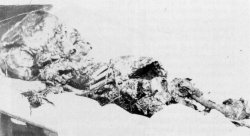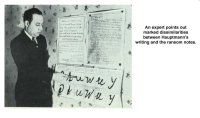THE INVOLVEMENT of ELLIS H. PARKER
in
THE LINDBERGH CASE
 PART 2: THE UNANSWERED QUESTIONS
PART 2: THE UNANSWERED QUESTIONS 
There were a number of things in the prosecutionís case against Hauptmann that just didnít add up. Ellis Parker questioned these inconsistencies. Here are a few of his , Hauptmann's and Governor Hoffman's questions about the case.
- How did Hauptmann or the kidnapper know the baby was there that night? The Lindberghs had never stayed over an extra night before. The decision was made last minute. Did someone inside the house call a friend?
- How did Hauptmann know where the nursery was or that that was the only shutter that couldn't be locked? There had to be an inside person.
- Why did no one else see the ransom note on the windowsill in the nursery? Lindbergh discovered it later, even though he had looked out the window when he first went into the nursery at the nurseís request.
- Why were there no fingerprints on the ladder or in the nursery? When the nurse went in to check on the baby she must have touched something as did Lindbergh when he went in and looked out the window. What happened to the fingerprints from before the baby was kidnapped? Did someone wipe the place clean when the baby was put to bed?
- Why did the police come back and fingerprint Hauptmann at least three times including prints of the side of his hands and palms if there were no fingerprints? Maybe there were no fingerprints because none of them matched Hauptmanns.
- How was Hauptmann able to get there so fast when he lived so far away? Wendel lived only 20 minutes away in Trenton.
- Why was the decomposition of the body found so accelerated for the time of year and length of time it was there? In the cool spring weather decomposition could not occur as rapidly as it had.
- How did Lindbergh and the nurse identify the body when the child's physician said he couldn't identify it for a million dollars? Given the state of decomposition shown in the pictures of the body, it was impossible to identify it as anyone. Could you?



- Why did Jafsie say he couldn't identify Hauptmann in a lineup and later identify him at the trial? Did his eyesight suddenly get better or did he figure the police said Hauptmann was guilty and he wanted the publicity as an identifying hero?
- How did Lindbergh recognize Hauptmann's voice from two words spoken two years ago? Or did he too think that since the police said Hauptmann was the one, he would bring closure for his family by identifying Hauptmann?
- What happened to the rest of the ransom money if Hauptmann was the only kidnapper? The prosecution carefully avoided this question as it would have blown their case.
- Why was the signature on the bank exchange of ransom notes by J .J. Faulkner not compared with Hauptmann's signature and followed up as a lead toward other possibilities? Maybe the authorities wanted to solve it quick and easy.A master forger with many aliases.


- Why did the police not follow up on J. J. Faulkner, an alias of Jacob J. Nosovitsky, a master forger, who fit most of the descriptions Jafsie gave of "Cemetery John?" The NY Daily News shows an expert agrees. There was someone else.
- Why didnít the footprints at Lindberghís house and at the cemetery not match Hauptmannís footprints? Nobody ever explained this one. They took Hauptmann's shoes to match them up and never brought it into evidence at the trial. Didn't they match?
- Why werenít Fischís letters to Hauptmann from Germany admitted into evidence? The prosecution and defense had them. Maybe Hauptmann's "Fisch" story would have turned out to be true and the prosecution's case blown wide open.
- What happened to the time sheets from Hauptmannís employer that were signed for by the state police? They showed Hauptmann had worked on the day of the kidnapping.
 Why didnít the ladder rail match exactly with the wood from Hauptmannís attic? The expert said it was because it was planed on the bottom.
Why didnít the ladder rail match exactly with the wood from Hauptmannís attic? The expert said it was because it was planed on the bottom.
Then WHY did it stick out above the wood on the top?
 Why would a carpenter build such a makeshift ladder? Hauptmann was an accomplished carpenter. He would have built a sturdy ladder with proper joints, not one that was crude and falling apart. He laughed when they showed it to him and said it looked like a musical instrument.
Why would a carpenter build such a makeshift ladder? Hauptmann was an accomplished carpenter. He would have built a sturdy ladder with proper joints, not one that was crude and falling apart. He laughed when they showed it to him and said it looked like a musical instrument.
- Why would Hauptmann cut a piece of wood from his attic that could be easily traced to him when he had many boards in his garage and a lumberyard was 2 blocks away?Wilentz said he was a smart criminal - that's not so smart.
- Why didn't the nailholes match properly in the attic rail and why did the holes in the beam look newer? Maybe someone pounded new nails through to make them match.
- Why didn't the ladder rail match the attic board exactly? Missing pieces??? But the rest of the boards matched all along their length.
- Why did Osborn, the handwriting expert change his testimony? When told the police were positive that Hauptmann was guilty the pressure from the prosecution was to find matches not dissimilarities.


- Why did the handwriting experts only look for similarities instead of the many more unsimilar writing features? Then he wouldn't have matched.
- Why did many of the prosecutionís witnesses say at first that they could not recognize the face or voice of the extortionist or passer of ransom money suddenly recognize him in court? Money was offered for witnesses.
- Why would Hauptmann write Jafsieís phone number in a dark place in his closet when he didnít even have a phone? A reporter admitted he wrote it there as a prank, but it was still used against Hauptmann at the trial.
- Why did some "witnesses" that said they hadn't seen anyone or anything suddenly change to say they had seen Hauptmann? Maybe they liked the money offered for testifying.
- Why did Hauptmann continue to maintain his innocence when Governor Hoffman offered to commute his sentence if he would confess to the crime? Maybe he was innocent.
- Why did the prosecution not want Wendel's confession? They had built up too much circumstantial evidence against Hauptmann and would have looked like fools.
 Why was the police artist's sketch from witnesses' descriptions never compared to photographs of Fisch, Wendel or others?
Why was the police artist's sketch from witnesses' descriptions never compared to photographs of Fisch, Wendel or others?
Too many of them would have matched it. What do you think?
- How did Wendel know so many of the unpublicized facts of the kidnapping he confessed to doing? He might have been the one who did it. Why did he brag to Ellis Parker that he knew who did it? He said he could solve it easily.
- Why did all these people identify and manufacture circumstantial evidence against Hauptmann? The pressure was enormous to find the perpetrator of the crime against America's hero. The investigation had been dead-ended for two years when Hauptmann was apprehended with the money. It was assumed by the press and everyone that he had to be guilty. All of the witnesses, police, lawyers, etc wanted to get in on the publicity of helping to solve the "Crime Of The Century."
- WHY?
WHY?
WHY?
 Return to Lindbergh Kidnapping Main Page
Return to Lindbergh Kidnapping Main Page
 PART 2: THE UNANSWERED QUESTIONS
PART 2: THE UNANSWERED QUESTIONS 
 PART 2: THE UNANSWERED QUESTIONS
PART 2: THE UNANSWERED QUESTIONS 





 Why didnít the ladder rail match exactly with the wood from Hauptmannís attic? The expert said it was because it was planed on the bottom.
Why didnít the ladder rail match exactly with the wood from Hauptmannís attic? The expert said it was because it was planed on the bottom.  Why would a carpenter build such a makeshift ladder? Hauptmann was an accomplished carpenter. He would have built a sturdy ladder with proper joints, not one that was crude and falling apart. He laughed when they showed it to him and said it looked like a musical instrument.
Why would a carpenter build such a makeshift ladder? Hauptmann was an accomplished carpenter. He would have built a sturdy ladder with proper joints, not one that was crude and falling apart. He laughed when they showed it to him and said it looked like a musical instrument.

 Why was the police artist's sketch from witnesses' descriptions never compared to photographs of Fisch, Wendel or others?
Why was the police artist's sketch from witnesses' descriptions never compared to photographs of Fisch, Wendel or others?